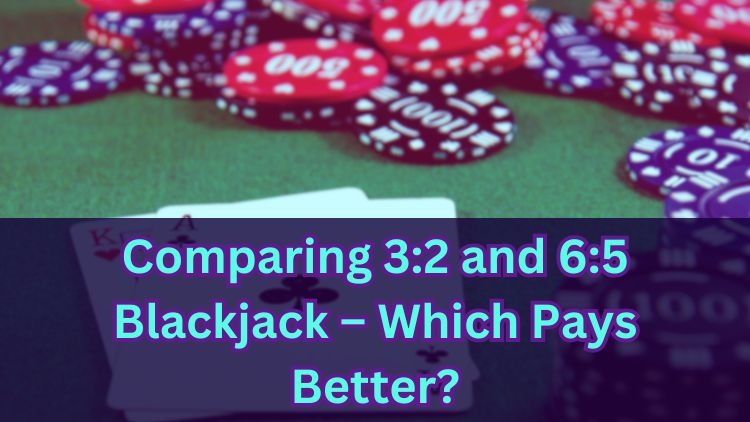
Blackjack is one of the most recognised card games in casinos. Yet, not every game pays the same when you land the best starting hand, known as a blackjack (an Ace plus a card worth ten).
You may notice tables labelled 3:2 or 6:5—these numbers describe how much you are paid when you hit that hand. Understanding the difference can help you make sense of what’s on offer, why payouts vary, and how those small differences can affect your potential returns over time.
What Do 3:2 and 6:5 Blackjack Payouts Mean?
In blackjack, the aim is to have a higher total than the dealer without exceeding 21. If your first two cards are an Ace and a 10-value card, you have a blackjack, and the payout depends on the table rules.
- At a 3:2 table, a £10 stake returns £15 profit for a blackjack.
- At a 6:5 table, the same £10 returns £12 profit.
This difference might not seem dramatic at first, but it directly affects the long-term potential return of the game. Casinos display payout details on the felt, signage, or within the game rules online, so it should be visible before you play.
How Does the House Edge Change Between 3:2 and 6:5 Blackjack?
The house edge is the percentage advantage the casino has over time. In blackjack, it is shaped by the payout rules, as well as other table rules.
On a standard 3:2 game, the house edge with basic strategy is usually around 0.4% to 0.5%.
Changing this to 6:5 raises the edge by roughly 1.3 to 1.4 percentage points, which means the casino keeps more of the total money wagered over many hands.
A natural blackjack occurs in about 1 in every 21 hands, or 4.8% of the time. By paying less for those winning hands, the overall potential return to the player decreases, and this is why payout structures matter.
Why Do Some Casinos Offer 6:5 Blackjack Instead of 3:2?
Casinos operate to make a profit. Offering 6:5 blackjack increases their margin, while still providing a familiar game.
In the UK, you may notice this format more often at lower-stake tables, or on digital versions with side features, depending on the casino.
In contrast, 3:2 blackjack tends to be the standard on higher-limit tables, or within live dealer formats online.
The difference allows casinos to balance offering lower minimum stakes while adjusting the payout potential to maintain revenue.
Blackjack Payout Examples in Pounds
To put the numbers into context, imagine playing 100 hands with £10 stakes and being dealt ten blackjacks.
- 3:2 blackjack: £15 profit per hand means £150 from those ten hands.
- 6:5 blackjack: £12 profit per hand means £120 from the same ten hands.
That’s a £30 gap purely from those blackjacks. The rest of the hands—whether wins, losses, or pushes—are unaffected by this payout rule, but over many sessions the difference can build up.
Which Version of Blackjack Gives Better Value for Players?
From a mathematical point of view, 3:2 blackjack offers better value, since it pays more for the same winning hand and usually has a lower house edge. However, “better” can be subjective.
- If you want the potential for higher long-term returns, 3:2 is generally preferable.
- If you prefer lower minimum stakes, or a particular side feature, you might find yourself at a 6:5 table.
The key point is that both options involve chance, and no version guarantees consistent returns. The payout structure simply shifts the expected average.
Is 6:5 Blackjack Ever Worth Playing?
This depends on what you want from the game. 6:5 blackjack reduces potential winnings, but some players may value tables with smaller minimum bets, or enjoy specific variants that only come in this format.
If the priority is the best possible payout, 3:2 remains stronger. If the priority is budget or variety, 6:5 may still appeal. As with all gambling, it comes down to personal preference and what aspects matter to you.
Key Things to Remember Before Choosing a Blackjack Table
Blackjack can vary depending on how it is set up, and the payout ratio is only one part of the picture. Other factors can influence the edge, such as:
- Number of decks used: more decks usually increase the house edge.
- Doubling rules: being able to double on any two cards, or after a split, is generally more favourable.
- Dealer on soft 17: if the dealer hits on a soft 17, the house edge rises by about 0.2%.
- Side bets: optional wagers with their own payout tables, usually carrying higher house edges than the main game.
If you check the rules before sitting down or opening a game online, you can quickly see how the setup works and decide which version may suit you.
A Note on Safer Gambling
Blackjack, like all casino games, is a game of chance. No strategy can guarantee consistent wins, and outcomes will vary. If you choose to play, it can help to:
- Set yourself a budget you are comfortable with.
- View any wagered money as the cost of entertainment.
- Take breaks if play stops being enjoyable.
Gambling should only be one form of entertainment, and never a way to try to make money. Please play responsibly.
*All values (Bet Levels, Maximum Wins etc.) mentioned in relation to these games are subject to change at any time. Game features mentioned may not be available in some jurisdictions.
**The information provided in this blog is intended for educational purposes and should not be construed as betting advice or a guarantee of success. Always gamble responsibly.
